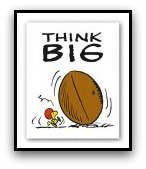Comic Strips and their
Place in Society!
Comic strips not only provide us with the laugh each day or week that we must have to start the day. They also give a political platform to some of the strip creators in which they can pass on their social and political opinions.
Comic-Strips and Their Social
and Political Influence
An excerpt from Wikipedia puts comments into a great perspective:
"The comics have long held a distorted mirror to contemporary society, and almost from the beginning have been used for political or social commentary. This ranged from the staunch conservative values of Little Orphan Annie to the unabashed liberalism of Doonesbury.
Pogo used animals to particularly devastating effect, caricaturing many prominent politicians of the day as animal denizens of Pogo's Okeefenokee Swamp. In a fearless move, Pogo's creator Walt Kelly took on Joseph McCarthy in the 1950s, caricaturing him as a bobcat named Simple J. Malarkey, a megalomaniac bent on taking over the characters' bird watching club and rooting out all undesirables.
Kelly also defended the medium against possible government regulation in the McCarthy era. At a time when comic books were coming under fire for supposed sexual, violent, and subversive content, Kelly feared the same would happen to comic-strips. Going before the congressional subcommittee, he proceeded to charm the members with his drawings and the force of his personality. The comic strip was safe for satire.
Some comic-strips, such as Doonesbury and Boondocks, are often printed on the editorial or op-ed page rather than the comics' page, because of their regular political commentary. Conservatives have long warred against Doonesbury, and were recently successful in convincing a major printer of Sunday comics' sections to refuse to print the strip (see Media bias in the United States). In another case, Dilbert is sometimes found in the business section of a newspaper instead because of the strip's commentary about office politics."
So as you can see, comic-strips have had a place in the opinionated lives of all of us. And they are not reserved for just the young or the young at heart. They can carry some strong sociological impact.
The Many Faces of Comic Strips
In general comic-strip characters remain un-aging throughout the strips' lives. But some, as in For Better or Worse by Lynn Johnston, the characters age as the strip's longevity continues. Gasoline Alley was the first strip to feature aging characters.
The history of comic-strips is not always filled with humorous creations, but also includes series that are serious and tell an ongoing dramatic story. Examples include Prince Valiant, Dick Tracy, Mary Worth, Modesty Blaise and Tarzan. Sometimes there are also spin-offs from comic books such as Superman, Batman, and The Amazing Spider-Man.
Although most comic-strips are centered on human beings, quite a number of strips have chosen to center around animals as main characters. Some are non-verbal like Marmaduke and some have verbal thoughts but aren't understood by humans, (Garfield, Snoopy in Peanuts) and some can converse with humans (Get Fuzzy). Other strips have centered entirely on animals, as in Pogo or Donald Duck.
Gary Larson's The Far Side was unique, as there were no central characters. Instead The Far Side used a wide variety of characters such as humans, monsters, aliens, chickens, cows, worms, amoebas and more. Wiley Miller not only mixes human, animal and fantasy characters, he does several different comic strip continuities under one umbrella title, Non Sequitur.
Newspaper comic-strips come in two formats, daily strips and Sunday strips. Daily strips usually run Monday through Saturday, and are, most of the time, printed in black and white. Sunday strips are much larger and are usually in color.
More for Comic Strip Fans
Here is a pretty amazing site that I have found that offers up quite a plentitude of comic strips . Be careful though or you could get engrossed all day and you might want to come back here.
You may also find a few pieces of literature worth reading at Amazon that may tickle your comic strips taste buds. Just click on the image to the left. Don't stay too long though, and come back here.
If you want to keep up on the varied and interesting activities going on in the world of comic books, then feel free to sign up for my newsletter "Comics Galore" in the form below. And by all means, I would love to hear your comments and opinions on comic strips as opposed to comic books. You can sure leave them for me at my contact page in the menu at the left. I may even be able to include them in my newsletter. I thank you ahead of time.
Dave Gieber










New! Comments
Have your say about what you just read! Leave me a comment in the box below.